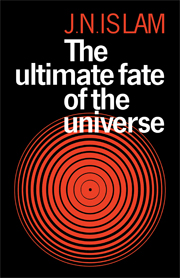Book contents
- Frontmatter
- Contents
- Preface
- Dedication
- Note on some conventions
- 1 Introduction
- 2 Our Galaxy
- 3 The large-scale structure of the universe
- 4 Elementary particles – a preliminary look
- 5 Is the universe open or closed?
- 6 Three ways for a star to die
- 7 Black holes and quasars
- 8 Galactic and supergalactic black holes
- 9 A black hole is not forever
- 10 Slow and subtle changes
- 11 Future of life and civilization
- 12 A collapsing universe
- 13 The steady state theory
- 14 The stability of the proton
- 15 Epilogue
- Glossary
- Selected bibliography
- Index
- Frontmatter
- Contents
- Preface
- Dedication
- Note on some conventions
- 1 Introduction
- 2 Our Galaxy
- 3 The large-scale structure of the universe
- 4 Elementary particles – a preliminary look
- 5 Is the universe open or closed?
- 6 Three ways for a star to die
- 7 Black holes and quasars
- 8 Galactic and supergalactic black holes
- 9 A black hole is not forever
- 10 Slow and subtle changes
- 11 Future of life and civilization
- 12 A collapsing universe
- 13 The steady state theory
- 14 The stability of the proton
- 15 Epilogue
- Glossary
- Selected bibliography
- Index
Summary
What will eventually happen to the universe? The question must have occurred in one form or another to speculative minds since time immemorial. The question may take the form of asking what is the ultimate fate of the Earth and of mankind. It is only in the last two or three decades that enough progress has been achieved in astronomy and cosmology (the study of the universe as a whole) for one to be able to give at least plausible answers to this kind of question. In this book I shall try to provide an answer on the basis of the present state of knowledge.
To appreciate the possibilities for the long-term future of the universe it is necessary to understand something of the present structure of the universe and how the universe came to be in its present state. This will be explained in some detail in Chapter 3. In this introduction, I shall briefly outline the contents of this book to provide a ‘bird's eye view’ to the reader. All the terms and processes mentioned in this summary will be explained in more detail in the succeeding chapters.
The basic constituents of the universe, when considering its large-scale structure, can be taken to be galaxies (Fig. 1.1), which are ‘islands’ of stars with the ‘sea’ of emptiness in between, a typical galaxy being a congregation of about a hundred billion (1011) stars (e.g. the Sun) which are bound together by their mutual gravitational attraction.
- Type
- Chapter
- Information
- The Ultimate Fate of the Universe , pp. 1 - 7Publisher: Cambridge University PressPrint publication year: 1983



